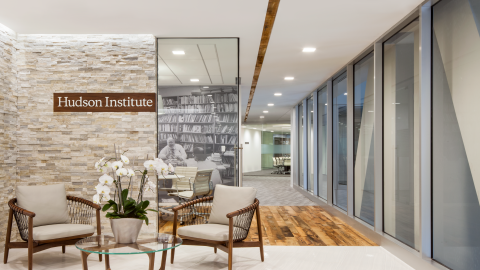Re: Building Defense is a limited series that highlights Hudson’s policy recommendations for revitalizing the US defense industrial base for great power competition. Subscribe here.
China has a massive and strategically significant advantage over the United States in the commercial maritime and shipbuilding industries. Washington needs to work closely with its partners to close this gap before it’s too late.
How Do We Get There?
1. No cheap fixes: Invest in a fleet proportionate to the threat environment.
2. Integrate the US defense industrial base with AUKUS allies.
3. Work more closely with Japan to meet US and allied shipbuilding needs.
Sketching Out the Details
1. Taking back China’s control of the seas will require smart, sustained investment.
Congress should keep certain principles in mind as it sorts through various proposals. It should not grasp at cheap fixes based on false premises but should understand that substantial government resources proportionate to the current threat environment will be needed. It should know specifically what to expect those resources will produce in terms of American ships and mariners added to the fleet, and shipbuilding capacity added to the industrial base. Government agencies managing those resources should be accountable for optimizing their value through innovative procurement processes and regular program reviews. And Congress should challenge the industry to meet goals of a size and on a schedule commensurate to the urgent threats of today. China may not wait for America to act before exploiting its advantages in this sector.
Read “America Shouldn’t Let China Control the Seas” by Michael Roberts.
2. Prime Minister Scott Morrison: Integrate the AUKUS defense industrial bases.
What [AUKUS] has to do is, as best as you are able, integrate the industrial bases of Australia, the United States, and the UK, and to have them operating almost as seamlessly as you possibly can in one ecosystem. And so you’ve got the spheres of government working together and your defense forces, and you’ve got your spheres of your industrial bases working together. And then you’ve got your spheres of groups, whether it’s like Hudson Institute or whoever it might be, think tanks, universities, the scientists, the technologists that are out there charting the narrative in the longer-term view about what this is. And all three of them, those spheres, have to come together. And that’s quite a bit to juggle, but that’s what makes AUKUS work. So I would say it’s more, in Pillar One, about really being able to knock down the barriers, which enables the free movement of people, capital, ideas, technology, and the integration of all of that as much as is humanly possible and technologically possible.
3. Help Japan overcome obstacles to become a major naval shipbuilding nation.
The US Navy remains the most powerful regional force. But from a defense industrial perspective, the United States is not a major exporter of naval combatant vessels. The Biden administration decided not to include funding to upgrade America’s naval shipyard manufacturing infrastructure in its $1.6 trillion infrastructure legislation. But because the administration has only been able to allocate 17 percent of these appropriated funds over a three-year period, a subsequent administration may be able to fund the renewal of US naval shipbuilding infrastructure. However, at present, the US Navy continues to shrink. Meanwhile, Japan’s technological and industrial capability to become a major naval shipbuilding exporter is apparent. If Tokyo overcomes these institutional obstacles, Japan could become an even greater US partner and contributor to Indo-Pacific security.
Read “How Japan Can Become a Major Exporter of Naval Combatant Vessels” by William Schneider.
















